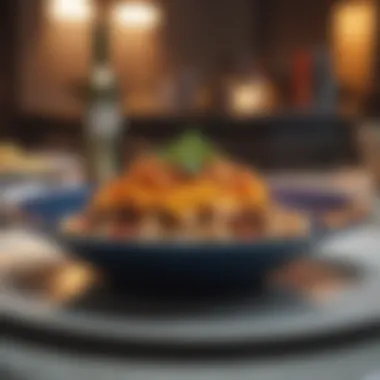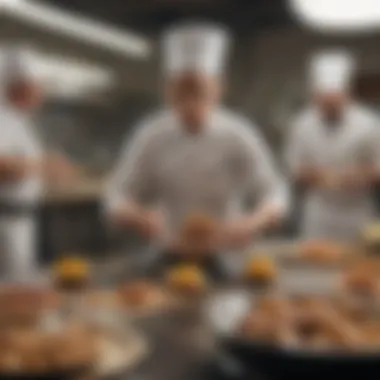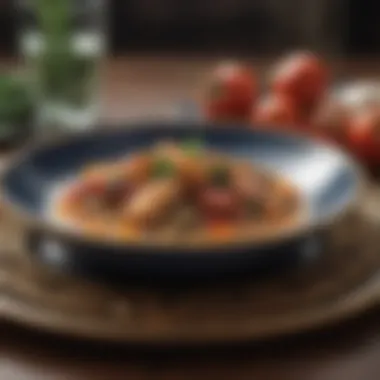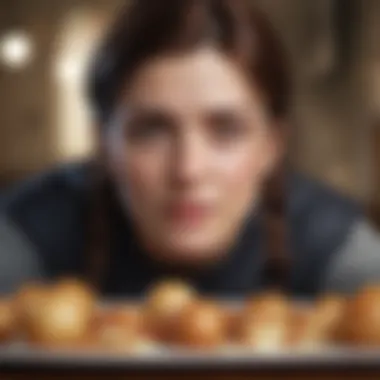Unveiling Food Wars: Season One Analysis and Insights


Intro
Food Wars establishes itself as a landmark series in anime by intricately weaving culinary artistry with intense competition. Season One serves as the gateway into this vibrantly crafted world where food becomes an arena for competition. We encounter not just the delectable dishes that are presented but also the characters that elevate this narrative. Their development through culinary challenges creates an engaging backdrop, exploring themes of ambition, rivalry, and self-discovery.
This article aims to dissect this foundational season, examining character dynamics, thematic depth, and overall cultural impact. By analyzing key episodes and production aspects, we will uncover the way Food Wars has influenced anime culture and engaged viewers around the globe. Through a structured approach, we will unveil the relationships forged in the heat of competition as well as the narrative strategies employed throughout.
Overview of Food Wars
The overview of Food Wars is essential to understand the nuances that the series brings to the table, both literally and metaphorically. As a culinary-focused anime, it intertwines culinary techniques with high-stakes competition. This section sets the foundation for analyzing characters, themes, and the broader cultural implications of the show.
Preface to the Series
Food Wars, or Shokugeki no Soma, first aired in 2015. The series follows the story of Yukihira Soma, a young chef who enrolls at the prestigious Totsuki Culinary Academy. This academy is known for its intense cooking competitions where students engage in "shokugeki", or food wars. The narrative quickly establishes a stylized framework for the culinary arts, blending anime tropes with professional-grade cooking challenges.
The characters portrayed in the series are richly developed, each representing different cooking philosophies and backgrounds. This diversity enhances the narrative and captures viewers' attention. The pacing of the story keeps the audience engaged, with each episode revealing new culinary techniques and personal growth. It's not just a cooking show; it’s a deep dive into passion, rivalry, and the relentless pursuit of excellence.
Culinary Themes Within the Narrative
At its core, Food Wars is about the artistry of cooking. The series explores several culinary themes that hold significance in both the narrative and the characters. One prominent theme is the idea of innovation versus tradition. Characters often clash over how to approach cooking; some prioritize traditional techniques while others advocate for modern methods. This conflict reflects a broader discourse present in the culinary world.
Additionally, the series emphasizes flavor profiles and sensory experiences. The characters frequently describe the intricacies of flavor through exaggerated visual and auditory elements, showcasing the importance of seasoning and presentation in cooking. This not only educates the viewer but also enhances their appreciation for food as an art form.
The thematic exploration of cooking aligns with the personal journeys of the characters. The challenges they face often force them to confront their beliefs about food and their abilities, reinforcing the idea that cooking is both a skill and a form of self-expression.
Cultural Impact of Food Wars
Since its release, Food Wars has significantly influenced both anime culture and culinary enthusiasts. The series has drawn attention to culinary arts in a way that few other shows have. It brings together a diverse audience, from anime fans to professional chefs, highlighting how food connects people across cultures.
The impact is evident on social media, where fans discuss recipes inspired by the series and share their culinary attempts. Notably, forums on Reddit have become hotspots for sharing fan creations and engaging in discussions about the episodes.
Moreover, the show has inspired culinary events and competitions. Chefs and food lovers often hold shokugeki-style contests, injecting a sense of playful competition into the cooking process.
Character Analysis
Character analysis plays a crucial role in understanding the narrative dynamics of Food Wars. This anime thrives on its multi-dimensional characters and their growth through culinary challenges. Each character serves not merely as a vessel to deliver the plot but as a representation of contrasting culinary philosophies and cultural backgrounds. This section will dissect the main protagonist, support characters, and key antagonists to reveal how their complexities enrich the story. By examining their motivations, relationships, and development, readers will gain an insightful perspective into what makes Food Wars a compelling series.
Main Protagonist: Yukihira Soma
Yukihira Soma stands at the heart of Food Wars, embodying the spirit of innovation and relentless competition. He comes from a humble background, having worked in his father's diner. Soma's culinary philosophy revolves around challenging conventions and pushing boundaries. This reflects his desire to improve and stand out in a prestigious environment like Totsuki Culinary Academy.
Soma exhibits resilience and confidence, often challenging skilled peers with a casual demeanor. His unique dishes consistently reflect his personality, combining bold flavors with unorthodox techniques. The audience witnesses his evolution from an underdog to a formidable contestant. Furthermore, his interactions with classmates reveal a deeper understanding of culinary art, showcasing growth in both skill and interpersonal dynamics.
Support Characters and Their Roles
The support characters in Food Wars add layers of depth to the narrative, bringing diverse skills and perspectives to the table. Each character embodies distinct culinary styles and philosophies, enhancing the competitive atmosphere of the series.
- Erina Nakiri: Known for her prestigious lineage, Erina initially appears as a strict and elitist figure. Her "God's Tongue" sets high standards for culinary excellence, and her evolving relationship with Soma highlights themes of rivalry and admiration.
- Alice Nakiri: Adds a playful contrast with her scientific approach to cooking. Her character showcases the balance between creativity and technique, enriching Soma's journey.
- Megumi Tadokoro: Represents the underdog struggle. Megumi’s growth amid adversity resonates with viewers, highlighting themes of determination and perseverance.


These characters not only support the protagonist's journey but also undergo their transformations, illustrating the complexities of culinary competition and teamwork.
Antagonists and Their Motivations
In Food Wars, the antagonists serve as significant obstacles that challenge Soma and his peers. They often hold traditional views, creating stark contrasts to Soma's innovative methods.
- Akumi Midou: Initially, she embodies culinary elitism, prioritizing tradition over creativity. Her battles with Soma provoke critical discussions about the future of cooking.
- Jouichirou Yukihira: Soma’s father may not fit the traditional antagonist mold, but his reputation and expectations create internal conflicts for Soma, pushing him towards self-discovery.
By examining their motivations, viewers appreciate the diverse perspectives within the culinary world. The intricacies of their antagonism not only heighten tension in cooking showdowns but also enrich the overarching themes of competition and innovation.
Episode Breakdown
The "Episode Breakdown" section serves a crucial role in understanding the overall narrative and thematic essence of Food Wars. This part of the article allows us to dissect the plot into manageable pieces, making it easier for readers to digest the intricate layers of storytelling woven throughout the first season. Each episode not only advances the storyline but also showcases culinary artistry that is pivotal to the series' appeal. By examining key episodes, critical turning points, and noteworthy culinary showdowns, we can better appreciate how Food Wars cultivates an engaging and memorable experience for its audience.
Key Episodes of Season One
Several episodes in the first season stand out due to their impact on character development and plot progression. One of the most significant is Episode 1, titled "Food Wars!" Here, we are introduced to Yukihira Soma, whose spirit and talent are exemplified during his inaugural cooking battle. This episode establishes the competitive atmosphere that permeates the series, emphasizing Soma's ambition and skill.
Another notable episode is Episode 8, "The Rice of Life." This chapter explores the relationship between food and memory, showcasing a dish that rekindles deep connections for one of the judges, adding emotional depth. This incrementally builds on the overarching theme that food transcends mere sustenance; it embodies passion, history, and personal stories.
Critical Turning Points
The first season contains multiple critical turning points that enhance not only the plot but also character arcs. For instance, Episode 10, "The Taste of Failure," serves as a pivotal moment for Soma. After facing defeat against an upperclassman, he grapples with self-doubt. This loss is essential as it shapes his determination and resilience, providing a narrative arc that resonates with viewers.
Another turning point emerges in Episode 13, "The Journeys of Top 10," where the preparation for the upcoming Totsuki Autumn Elections heightens the stakes. This episode sets the direction for future conflicts while further establishing relationships among characters.
Noteworthy Culinary Showdowns
Culinary showdowns in Food Wars are not just competitions; they symbolize the clash of philosophies and styles in cooking. A standout moment occurs during the match between Soma and Fumio Daimidou in Episode 4, "The First Seat." This match is particularly memorable for its intensity and the unique techniques displayed. Soma’s innovative methods clash with the traditional style of his opponent, illustrating the series' theme of progress versus tradition.
In Episode 11, "The Last Dish," Soma faces off against Erina Nakiri in a highly anticipated battle. The stakes are enormous as it involves not only cooking skill but emotional growth. This showdown showcases not only culinary expertise but also personal growth, highlighting Soma's evolution as a chef and individual.
Understanding these episodes provides deeper insights into the characters and the narrative's progression. Each culinary battle reveals the dimensions of the characters and reflects broader themes relevant in culinary arts.
In summary, the "Episode Breakdown" is indispensable for grasping the intricacies of Food Wars. It enriches the viewer's understanding, guiding them through pivotal plot developments and character progressions. By dissecting key episodes, critical turning points, and noteworthy showdowns, we see the depth of storytelling that Food Wars delivers, inviting the audience into a world where culinary mastery meets fierce competition.
Art and Animation Style
The art and animation style of Food Wars plays a crucial role in communicating its themes and enhancing the viewer's experience. It is not merely a backdrop; it elevates the narrative and intensifies the emotions surrounding the culinary battles. The intricate details in the food representations and character designs immerse the audience in a vibrant world that celebrates gastronomy.
Visual Aesthetics of Food Portrayal
In Food Wars, the portrayal of food is not just visual but also an integral part of storytelling. Each dish is animated with meticulous detail, bringing the culinary creations to life. The visuals often elevate the importance of food as a character in itself. Colors are vibrant, and textures are highly defined, making the dishes almost tangible. This emphasis on aesthetics allows viewers to appreciate the creativity and skill involved in cooking.
The contrast between various styles of cooking is also portrayed effectively. For example, traditional Japanese dishes are depicted with a focus on cultural heritage, while more modern culinary approaches might use more experimental designs. This distinction highlights the diverse influences on food and how they shape culinary identity.
Character Design and Aesthetic Choices
Character design in Food Wars reflects both personality and role within the story. Each character is distinct, designed to communicate their culinary philosophy and background. The protagonists, like Yukihira Soma, depict youthful energy with a dynamic design, often featuring clothing that mirrors their culinary ambitions. Supporting characters also sport unique visual traits, signifying their own culinary journey.


Aesthetic choices extend to the characters’ expressions during cooking challenges as well. Exaggerated facial expressions connect viewers with their emotions – be it passion, joy, or fear. This technique not only emphasizes the competitive nature of the series but also builds a connection to the audience.
Cinematic Techniques in Food Wars
Food Wars employs various cinematic techniques to enhance storytelling. One prominent technique is the use of close-ups during cooking and tasting scenes. This directs viewer focus to the food, allowing for an appreciation of its intricacies and inviting the audience into the experience.
Additionally, dynamic camera movements during chef battles create a sense of excitement and urgency. The pacing of these sequences, combined with strategic cuts, keeps viewers engaged. It’s important to note how sound design complements these visuals, with sizzling sounds and clinking utensils enhancing the ambiance.
"The cinematic approach in Food Wars is not just a stylistic choice but a fundamental part of how culinary art is presented and appreciated onscreen."
In summary, the art and animation style in Food Wars plays a significant part in the overall impact of the series. From the visual portrayal of food to the careful design of characters, every element is crafted to engage the audience and celebrate culinary arts in a compelling way.
Sound and Music
Sound and music play a crucial role in shaping the atmosphere and emotional tone of Food Wars. The aural elements not only enhance the viewing experience but also serve to underscore the high-stakes culinary battles that define the series. The score and sound design work in harmony to create a vivid auditory landscape that complements the vibrant visuals and storytelling. Understanding these elements provides deeper insight into how Food Wars captivates its audience.
Score and Soundtrack Overview
The musical score of Food Wars combines various genres and styles to create an engaging backdrop for the unfolding drama in the kitchen. The soundtrack includes orchestral pieces that amplify the intensity of cook-offs, interspersed with lighter, comedic themes that add levity to character interactions.
Key elements of the score include:
- Dramatic Crescendos: These are strategically placed during pivotal cooking moments, raising the tension and excitement for the audience.
- Character Themes: Distinct musical motifs associated with main characters help to reinforce their personalities and arcs as the story progresses.
- Cultural Influences: Given the culinary focus, elements of traditional Japanese music weave into the score, echoing the diverse culinary practices showcased in the series.
"The soundtrack functions as both a narrative device and an emotional guide, steering audience perception through the trials of the characters."
The diversity in the score reflects the varied themes of competition, friendship, and personal growth, making it a vital part of the overall experience.
Sound Design in Cooking Scenes
The sound design in Food Wars elevates the cooking scenes to new heights, transforming mundane kitchen noises into an orchestra of culinary creativity. Every slice, chop, and sauté becomes a part of the sonic tapestry, allowing viewers to feel each moment's impact.
Important aspects of the sound design include:
- Realistic Culinary Sounds: The fidelity of sounds—like sizzling, chopping, and boiling—immerses viewers in the cooking process, creating the sensation of being present in the kitchen.
- Dynamic Sound Effects: As dishes are prepared and judged, the sound effects enhance the drama, giving a sense of urgency and importance to each culinary creation.
- Support in Emotional Moments: The sound design also emphasizes key emotional points, such as when characters succeed or fail, allowing the audience to resonate with their feelings more profoundly.
Narrative Structure
Narrative structure serves as the backbone of any storytelling medium, and in Food Wars, it plays a crucial role in crafting a captivating viewing experience. By intertwining character arcs, thematic depth, and episode pacing, the narrative structure cultivates an engaging atmosphere that invites the audience to immerse themselves in the world of culinary competition. The sequence of events, from conflict initiation to resolution, leads to emotional investment in the characters and their journeys.
In Season One, the narrative structure emphasizes the significance of competition in culinary arts. This is not merely about the food — it's about the individual characters and their distinct motivations. The well-planned progression across episodes allows the viewer to grasp the stakes involved in each cooking duel, tying back to the protagonist's growth and challenges faced along the way. As such, the rhythm and flow of the storyline contribute to both excitement and anticipation within the audience.
The manipulation of narrative arcs enables the show to reflect broader themes, such as resilience and the quest for identity. Each story arc has its own rhythm and conflict which ultimately serve to reinforce the central themes, providing a framework through which the audience can explore complex emotional and cultural landscapes.
"In a well-structured narrative, every element must support the greater story, creating coherence that resonates with viewers."
Thus, a thoughtful examination of the narrative structure reveals how it not only enhances character engagement but also deepens thematic exploration within Food Wars, establishing its significance in the culinary anime genre.
Story Arcs and Themes


Food Wars presents multiple story arcs that contribute to a complex narrative framework. The main arc follows Yukihira Soma as he navigates the intense environment of the Totsuki Culinary Academy. His journey, filled with challenges and culinary battles, represents the broader theme of self-discovery and perseverance. Each episode features cooking duels that symbolize not just competition, but personal growth and ambition. Soma's relentless determination to outperform his peers emphasizes resilience, a central theme throughout the series.
Additionally, various secondary arcs explore the backstories of supporting characters, enriching the narrative with diverse perspectives on culinary arts. These character-focused arcs reveal their individual struggles and aspirations, further highlighting the theme of ambition against adversity. Viewers gain insight into how each character's culinary journey interconnects, enhancing their collective growth.
In summary, the narrative arcs encapsulate a mixture of personal and societal challenges, which resonate strongly with the audience, making their experiences more relatable and impactful.
Character Development Throughout the Season
Character development is pivotal in Food Wars, contributing significantly to the overall narrative structure. Yukihira Soma starts as a brash but talented cook, whose ambition drives him to Totsuki. However, as the series progresses, his character evolves, revealing deeper layers of determination and vulnerability. The importance of learning and growth is exemplified through his experiences during cooking duels.
Supporting characters, such as Erina Nakiri and Megumi Tadokoro, also undergo noticeable evolution. Erina's initial air of superiority slowly transforms into a deeper understanding of culinary passion, while Megumi gains confidence through her experiences, emphasizing themes of teamwork and mentorship. Each character's growth is articulated through their interactions and confrontations, painting a rich tapestry of development.
Audience Reception
Understanding the audience reception of Food Wars is crucial to grasp its cultural significance and narrative impact. The response from viewers provides insight into how the series resonates with fans and critiques alike. Evaluating what aspects of the show were celebrated or scrutinized can inform future adaptations and iterations in the culinary anime genre. By analyzing audience feedback, one can draw connections between narrative elements and viewer engagement, revealing deeper truths about the storytelling techniques employed. Additionally, the reception sheds light on cultural trends and societal attitudes towards food and competition within media.
Critical Reviews and Fan Feedback
Critical reception to Food Wars has played a significant role in its success and prolonged relevance. Reviewers highlight the unique fusion of culinary arts and anime tropes, emphasizing its innovative approach within the genre. Many critics appreciate the character development, particularly the growth seen in Yukihira Soma, which reflects a relatable journey of overcoming challenges.
Fans, on the other hand, often express their love for the vibrant food animation and the intensity of the cooking competitions. The sense of community fostered by the series is palpable through online platforms, where discussions and theories thrive. Review sites like Rotten Tomatoes and MyAnimeList reflect a favorable consensus, which confirms the series' effective execution of both narrative and technical components.
Key Review Highlights:
- Visual Appeal: Many assert that the show's animation quality is a distinguishing factor that elevates its culinary battles.
- Character Engagement: The ensemble cast, each with unique personalities, draws viewers into their interconnected stories.
- Complex Themes: Some reviews mention the underlying themes of rivalry and self-discovery that speak to a broader audience beyond individual episodes.
Positive reviews tend to create a ripple effect, encouraging new viewers to explore the series. This snowball effect can significantly contribute to the show's sustained popularity and engagement.
Cultural Resonance and Community Engagement
The cultural impact of Food Wars cannot be underestimated. It has ignited a renewed interest in culinary arts within anime, blending entertainment with potential educational inspiration. Fans have turned to Food Wars as a springboard for discussions about gastronomy, leading to increased engagement in cooking-related community projects.
Online forums, including Reddit and various social media platforms, have become hubs for fan theories, recipes inspired by the series, and even cosplay efforts. This collaborative environment fosters a deeper connection to the narrative, as audiences feel a shared passion for the culinary themes.
Moreover, the series has sparked events related to culinary arts, such as workshops and competitions, mirroring the format present in the show. These active participations help solidify Food Wars' place in contemporary culture and extend its reach beyond traditional viewership.
For those examining anime's relationship with food, Food Wars serves as a landmark. Its success illustrates how culinary storytelling can transcend mere entertainment, creating lasting engagement and cultural discussions.
Finale
Summation of Key Insights
In summing up, this season adeptly integrates ambition, creativity, and personal growth within the competitions. Several key insights emerge:
- Character Development: The evolving arcs of characters, especially Yukihira Soma, showcase the intense pressure and passion inherent in culinary arts.
- Culinary Techniques: The focus on real-world cooking methods enhances authenticity and educational value.
- Cultural Relevance: The show reflects and influences contemporary culinary trends, bridging traditional and modern practices.
These elements not only contribute to the narrative's appeal but also elevate the storyline, making it compelling for viewers. The engagement from audiences creates a unique space where culinary arts and entertainment converge.
Legacy of Season One in Future Installments
Looking into the future, the legacy of Food Wars' first season lays a strong foundation for subsequent installments. The thematic richness and character complexity established in Season One pave the way for deeper explorations of culinary competition. Future seasons build on initial premises, introducing new elements while maintaining core themes.
- Expanded Universe: New characters and settings enrich the narrative, allowing for more diverse competition formats.
- Thematic Depth: As the series progresses, themes such as friendship, rivalry, and resilience are further examined, ensuring continuity in character motivations.
- Culinary Evolution: With a focus on innovation in cooking practices, viewers can expect to see how culinary arts evolve and adapt to changes in cultures.
Ultimately, the first season creates a lasting impact, ensuring that its lessons and experiences continue to resonate with audiences and influence future narratives in the anime genre.



